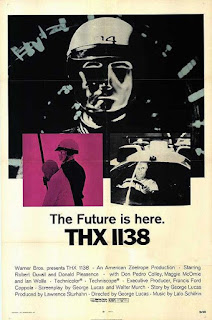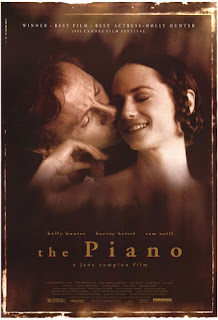December 1st: THX 1138 (George Lucas, 1971)
George Lucas attended Film School at USC in the early days of the program, already influenced by experimental and foreign language films he had seen as a teenager. He continued his studies as a graduate student, and during this time made the short film Electronic Labyrinth: THX 1138 EB, which would take the top prize at a National Student film festival. Awarded an internship at Warner Bros. studios, he soon became friends with fellow film school graduate Francis Ford Coppola, and the two formed the independent studio American Zoetrope.
Zoetrope would serve as a proving ground not only for Lucas and Coppola, but for the pair's friends and former classmates, many of whom would help to form what became known as the "New Hollywood" generation. After working on Coppola's film The Rain People as a behind-the-scenes documentarian, Lucas was ready to direct his first feature as part of a deal made between Zoetrope and Warner Bros., and chose to expand his earlier short.
Lucas wrote the first draft himself, and then collaborated with fellow USC alum Walter Murch on the final script. In the spirit of the anti-war movement, speech excerpts from President Richard Nixon were included in some of the dialogue. Hoping to shoot on location in Japan, Lucas was forced to remain in San Francisco for budgetary reasons.
The title role was played by previous Zoetrope collaborator Robert Duvall, joined by stage actress Maggie McOmie and Hollywood veteran Donald Pleasance (You Only Live Twice, Halloween). All the actors were asked to shave their heads for their roles, and Lucas would bring in patients from a local rehab facility (where the hairstyle was mandatory) to use as extras. Voiceover work heard throughout the film was provided (and improvised) by The Committee, an experimental theatre group.
In order to give his futuristic vision a sense of realism, Lucas shot in many modern-looking San Francisco locations, including the then-unfinished BART subway tunnels, various government buildings and scientific facilities, the San Francisco International Airport, a Frank Lloyd Wright municipal building, and a local telephone exchange. Additional indoor scenes were shot on a soundstage in Los Angeles.
Lucas was given a year to shape the film, working on an editing bay at home and alternating shifts with Murch, who focused on the innovative sound design. Warner Bros. executives were not pleased with the initial cut, and brought in their own editor to remove 4 minutes from the film. It was released in 1971 and received positive notices from prominent critics and publications, but failed to register at the box office. In the years to follow it proved hugely influential in science fiction films and stories, as well as electronic music, and in 2004 Lucas shot new footage and added CGI to enhance the scope of the story's setting, resulting in a limited theatrical re-release.
Running time is approx. 90 min.










Comments
Post a Comment